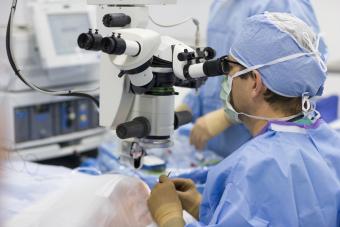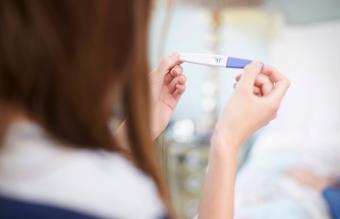
It is possible to get pregnant after you get your tubes tied. Your chance of pregnancy is low, however, if you are worried you might conceive after the procedure. On the other hand, if you do want to have a baby after you tie your tubes, there are ways to accomplish this.
The Chance of Pregnancy After Tubal Ligation
Tubal ligation ("getting your tubes tied") is one of the most effective methods of birth control and is considered permanent. It is a great option if you are certain you don't want to or should never get pregnant again.
However, it is not 100 percent effective to prevent you from getting pregnant. There is an overall 0.5 percent chance of pregnancy after a procedure in which the tubes are burned, cut, clipped, sutured, or plugged with implants.
The Risk of Pregnancy Extends over Years
Pregnancy is more likely in the first year after a tubal ligation (TL). Although the chance of conception decreases after one year, you can still get pregnant years after the procedure.
A Centers for Disease Control and Prevention (CDC) sterilization study published in 1996 in the American Journal of Obstetrics and Gynecology showed:
- At one year a total of five out of 1,000 women got pregnant (0.5 percent).
- The subsequent risk was about two pregnancies per 1,000 women per year (0.2 percent).
- By the end of five years, the total chance of pregnancy was 13 out of 1,000 women (1.3 percent).
- The total 10-year chance of conception ranged from 53.4 to 36.5 per 1,000 women (5.3 to 3.6 percent) depending on how the tube was tied.
Factors That influence the Risk of Pregnancy
From the CDC study, the two main factors that influence your risk of getting pregnant after you tie your tubes are:

- Your age at the time of the procedure: Women younger than 30 had a higher risk of conceiving 5 years post TL than women 30 years and older.
- The method used to tie your tubes: As summarized in Table I in an Obstetrics and Gynecology 2013 Practice Bulletin, based on the method used, these were the chance of conceiving by five years per 1,000 women:
- Clips on the tubes: 31.7 (3.2 percent)
- Burning the tubes (coagulation): 16.5 (1.6) percent
- Silicone bands: 10 (1.0 percent)
- Tubes cut after delivery of a baby: 6.3 (0.63 percent)
- Tubal implants (Essure): 1.64 (0.16 percent)
Reasons for Failure of Tubal Ligation
A tubal ligation prevents your eggs from meeting sperm in your tubes for fertilization. The procedure can fail for the following reasons:
- There is a small risk the tubes were not adequately tied at the time of the procedure. This is the more likely reason for a pregnancy during the first year or two after tubal ligation.
- The blocked tubes might reopen (re-canalize) or the two separated ends rejoin - the more likely cause of a pregnancy years after the procedure.
- You may have been already pregnant at the time of the procedure and this fact was missed.
Getting your tubes tied just after your period ends and before you ovulate also decreases your risk of a missed pregnancy. It is also important to get a pregnancy test before your procedure.
Precautions After Tying Your Tubes
To decrease your chance of pregnancy right after getting your tubes tied:
- Wait one week after the surgery before having intercourse.
- Use a back-up method of birth control for the first three months after the procedure, such as the birth control pill or condoms, especially if you had tubal implants.
- After tubal implants, at three months, make sure you get a tube dye test (hysterosalpingogram), as your doctor will advise, to make sure your tubes are blocked. He might advise this for other methods of TL as well.
Be aware of the earliest pregnancy signs and symptoms, such as a missed period, nausea, or breast tenderness. Talk to your doctor if you think you might be pregnant after you get your tubes tied.

The Risk of Ectopic Pregnancy With Tied Tubes
If you are one of the 0.5 percent women who conceive after getting your tubes tied, you have a risk of having an ectopic pregnancy. The embryo can implant in the tube and less frequently in the ovary or the abdominal cavity and put you at great risk.
The Amount of Risk
According to a Postgraduate of Medicine article, 15 to 20 percent of pregnancies post tubal ligation are ectopics. The authors of the CDC study cited above published an analysis of the ectopic pregnancies in the database of 10,685 study women in a 1997 New England Journal of Medicine article:
- The chance of having an ectopic pregnancy was 7.3 per 1000 women by ten years after tubal ligation.
- For women younger than age 30, the chance was 27 times higher for those who had burned tubes compared to those who had their tubes cut post-partum.
An ectopic pregnancy is more likely three or more years after the procedure.
How to Get Pregnant After a Tubal Ligation
If you come to regret getting your tubes tied and want to have a baby, you might prefer to use a surrogate. On the other hand, if you want to get pregnant instead, consider a tubal ligation reversal (TLR) or in vitro fertilization.
Tubal Ligation Reversal

Tubal ligation reversal (TLR) is a highly specialized microsurgery procedure to reattach the ends of the tube (re-anastomosis). The overall pregnancy success rate after a TLR ranges from 40 to 85 percent according to the Mayo Clinic, with an average of 50 percent.
The best chance of pregnancy is in the first year post TLR. A successful procedure after a reversal depends on:
- The experience of the fertility specialist with this procedure
- How long ago your tubes were tied
- Your age at the time of the reversal - because pregnancy rates decrease with age
- The procedure that was used to tie your tubes - burned tubes are less successful than other TL methods because of the amount of tubal damage and clips and rings are the most successful to reverse
- How much normal tube the surgeon can salvage and therefore the length of the tube that remains afterwards
The cost of a tubal ligation reversal is about $10,000, and most insurance companies will not cover it. If you don't get pregnant after the procedure, a second TLR is unlikely to be successful. Note also that, similar to a tubal ligation, there is a risk of ectopic pregnancy after a TLR.
In Vitro Fertilization
In vitro fertilization (IVF) bypasses the problem of blocked fallopian tubes from any cause. It is therefore an appropriate procedure to consider after a tubal ligation. With IVF, sperm is added to your eggs in a culture dish, and the resulting early embryo is transferred to your uterus, thus bypassing your tubes.
The success rate for IVF is 20 to 30 percent. The cost is about $12,000 or more per cycle. Discuss with your doctor the choice between TLR and IVF for your situation.
When to Consult Your Doctor
If you miss your period or have abnormal bleeding at any time after tying your tubes or after a TLR, you can start by doing a home pregnancy test. Because of the risk of pregnancy, even years later, go see your doctor as soon as possible whether the test it is positive or negative.
The risk of ectopic pregnancy makes it even more important to consult with your doctor, especially if you also have one-sided abdominal pain or feel lightheaded or faint. An ectopic pregnancy can rupture and cause internal bleeding and put your life at risk.
Consider Your Options
Before you decide to tie your tubes, consider all your options for long-term birth control that are as effective as tubal ligation. These include the IUD and the hormonal implant. In addition, discuss a choice of vasectomy for your partner. Consider all the aspects of your life to make sure getting your tubes tied is the right choice for you.







